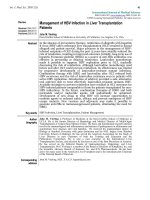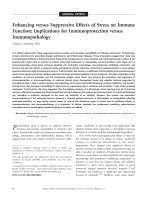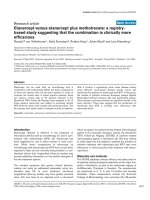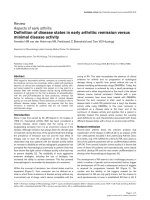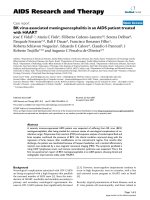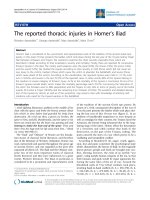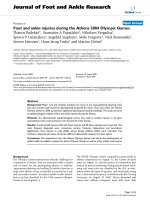Báo cáo y học: "Earthquake-related versus non-earthquake-related injuries in spinal injury patients: differentiation with multidetector computed tomography" pptx
Bạn đang xem bản rút gọn của tài liệu. Xem và tải ngay bản đầy đủ của tài liệu tại đây (621.88 KB, 10 trang )
RESEARC H Open Access
Earthquake-related versus non-earthquake-related
injuries in spinal injury patients: differentiation
with multidetector computed tomography
Zhi-hui Dong
1
, Zhi-gang Yang
1,2*
, Tian-wu Chen
1
, Zhi-gang Chu
1
, Qi-ling Wang
1
, Wen Deng
1
, Joseph C Denor
3
Abstract
Introduction: In recent years, several massive earthquakes have occurred across the globe. Multidetector
computed tomography (MDCT) is reliable in detecting spinal injuries. The purpose of this study was to compare
the features of spinal injuries resulting from the Sichuan earthquake with those of non-earthquake-related spinal
trauma using MDCT.
Methods: Features of spinal injuries of 223 Sichuan earthquake-exposed patients and 223 non-earthquake-related
spinal injury patients were retrospectively compared using MDCT. The date of non-earthquake-related spinal injury
patients was collected from 1 May 2009 to 22 July 2009 to avoid the confounding effects of seasonal activity and
clothing. We focused on anatomic sites, injury types and neurologic deficits related to spinal injuries. Major injuries
were classified according to the grid 3-3-3 scheme of the Magerl (AO) classification system.
Results: A total of 185 patients (82.96%) in the earthquake-exposed cohort experienced crush injuries. In the
earthquake and control groups, 65 and 92 patients, respectively, had neurologic deficits. The anatomic distribution
of these two cohorts was significantly different (P < 0.001). Cervical spinal injuries were more common in the
control group (risk ratio (RR) = 2.12, P < 0.001), whereas lumbar spinal injuries were more common in the
earthquake-related spinal injuries group (277 of 501 injured vertebrae; 55.29%). The major types of injuries were
significantly different between these cohorts (P = 0.002). Magerl AO type A lesions compose d most of the lesions
seen in both of these cohorts. Type B lesions were more frequently seen in earthquake-related spinal injuries (RR =
1.27), while we observed type C lesions more frequently in subjects with non-earthquake-related spinal injuries
(RR = 1.98, P = 0.0029).
Conclusions: Spinal injuries sustained in the Sichuan earthquake were located mainly in the lumbar spine, with a
peak prevalence of type A lesions and a high occurrence of neurologic deficits. The anatomic distribution and type
of spinal injuries that varied between earthquake-related and non-earthquake-related spinal injury groups were
perhaps due to the different mechanism of injury.
Introduction
The magnitude 8.0 Sichuan earthquake that happened at
2:28 PM Beijing time on 12 May 2008 injured an esti-
mated 374,643 people. A retrospective study of t he fea-
tures of 223 patients with spinal injuries was performed
using multidetector comp uted tomography (MDCT).
This study re lied on the 2,728 patients with earthquake-
related spinal injuries seen in a key university hospital [1].
Located 92 km from the Wenchuan County epicenter,
this 4,300-bed hospital served as an important intact res-
cue center immediately following the earthquake.
Spinal injuries acco unt for 1 3.0-15.2% of earthquake-
related trauma patients [2,3] and 1.6-10% of all other
trauma patients [4,5]. In general, the major etiologies of
spinal injuries include motor vehicle accidents, falls, ath-
letic mishaps, penetrating injuries and industrial acci-
dents [6,7]. In contrast, the spinal injuries sustained by
the 223 patients during the Sichuan earthquake usually
occurred from crush injuries followed by falls. Although
the features of earthquake-related spinal injuries have
* Correspondence:
1
Department of Radiology, West China Hospital of Sichuan University,
Chengdu 610041, China
Full list of author information is available at the end of the article
Dong et al. Critical Care 2010, 14:R236
/>© 2010 Dong et al.; licensee BioMed Central Ltd. This is an open access article distributed under the terms of the Creative Commons
Attribution License (http://creativecomm ons.org/licenses/by/2.0), which permits unr estricted use, distribution, and reproduction in
any medium, provided the origina l work is properly cited.
beenstudied[1],noonehasreportedthedifferences
between earthquake-related and other spinal injuries.
We propose that there is a difference between these two
types of injuries on the basis of their MDCT features
because of their different injury mechanisms. MDCT is
a fast and reliable modality to determine the pattern
and severity of spinal injuries and the degree of spinal
instability [8].
Classification based on the information provided by
MDCT should provide concise information regarding
the severity of the injury and guide the choice of treat-
ment. We used MDCT alone to evaluate the difference
between spinal injuries from earthquake victims and
those from other causes, which may help in clinical
management algorithms. We cite better disaster prepa-
redness as an overarching goal of this investigation.
Materials and methods
Patients
The study was approved by the ethics committee of our
medical school, and because of the retrospective nature
of this study, informed consent was waived. Of the
2,728 patients with earthquake-related spinal injuries
seen in our hospital, we consecutively enrolled patients
into the exposed cohort according to the following cri-
teria: (1) the etiolo gy of the injuries was associated with
the 2008 Sichuan earthquake, (2) spinal injuries were
evaluated using MDCT, and (3) the patie nts had not
received related surgical treatment before the spinal
MDCT scan. To avoid bias, we excluded patients injured
in an earthquake-related motor v ehicle accident. With
the exception that the etiology of spinal injury was not
ass ociated with the earthqua ke, simil ar inc lusive criteria
were used to enroll patients into the cohort of patients
with other common injuries ( unexposed cohort). By 4
June 2008, we had enrolled all 223 patients with clini-
cally worrisome spinal injuries from the Sichuan earth-
quake who met the in clusive criteria. We selected an
unexposed cohort similar in size to the exposed cohort
of 223 consecutive patients. To avoid the confounding
effect of seasonal activity and clothing, our unexposed
cohort was collected during a similar time frame of
1 May 2009 to 22 July 2009.
MDCT protocols
Among the earthquake-exposed cohort, spinal CT scans
of 10, 175 and 38 patients were performed using the
Philips Brilliance 64-slice MDCT (Philips Healthcare,
Eindhoven, the Netherlands), the Siemens Somatom
Sensation 16-slice MDCT and the Siemens Somatom
Plus 4-slice MDCT (Siemens Medical Systems, For-
chheim, Germany), respectively. Among the unexposed
common injury cohort, the 223 spinal CT scans were
performed using the Siemens Somatom Sensation
16-slice MDCT. Each patient underwent MDCT along
the z-axis from the upper two vertebrae to the lower
two vertebrae of the target vertebrae. Scanning para-
meters were 140 kV, 250 mAs, rotation time 1.0 s, pitch
1.235 and collimation of 64 × 0.625 mm for the Philips
Brilliance 64 MDCT scanner; 120 kV, 250 mAs, rotation
time 0.75 s, pitch 1.0 and collimation of 16 × 0.75 mm
for the Siemens Somatom Sensation 16-MDCT scan;
and 120 kV, 180 mAs, rotation time 0.75 s, pitch 1.5
and collimation of 4 × 1.0 mm for the Siemens Soma-
tom Plus 4 MDCT scan . The axial image data w ere
reconstructed in 1- to 2-mm thickness and 0.7- to 1.0-
mm increments and transferred to syngo Workflow soft-
ware of the picture achieving and communicating sys-
tem work station (PACS; Siemens Medical Solutions).
Image analysis
All MDCT scans were read independently by two
experienced radiologists (ZGY and ZHD, with 23 and 9
years o f experience, respectively) on a syngo Workflow
PACS workstation o n which we obtained axial images
and multiplanar reformatted sagittal and coronal images.
Surface-shaded display was used to evaluate the verteb-
ral fractures and the deformation o f the spinal column.
Discrepancies in interpretation were resolved by
consensus.
At each vertebral site, the presence of fractures in the
vertebral body, including the transverse processes, spi-
nous processes, articular processes and isthmus of the
vertebrae, as well as the degree of spinal canal narrow-
ing, were evaluated, with differences resolved by consen-
sus. We categorized the inju ry patterns and regions of
spinal injuries and correlated these findings with the
mechanism of injury and the clinician-evaluated Frankel
level [6]. Spinal injuries were subdivided into major and
minor injuries [9].
Major spinal injuries were categorized according to
the Magerl (AO) classification because it allows categor-
ization of injuries to all relevant parts of the spine
(Figures 1, 2, 3, 4) [10-12]. As for Magerl AO types,
spina l injuries are grouped as ty pe A, type B and type C
lesions. Type A (compression injuries of the anterior
column) is subdivided into A1 (impaction fractures), A2
(split fractures) and A3 (burst fractures). Type B (dis-
traction injuries of the anterior and posterior columns
with transverse disruption) is subdivided i nto B1 ( pos-
terior disruptions that are predominantly ligamentous),
B2 (posterior disruptions that are predominantly oss-
eous) and B3 (anterior disruptions through the disk).
Type C (anterior and posterior element injuries with
superimposed rotation resulting from axial torque) is
subdivided into C1 (type A injuries with rotation), C2
(type B injuries with rotation) and C3 (rotational shear
injuries). Injuries of three to seven cervical vertebrae
Dong et al. Critical Care 2010, 14:R236
/>Page 2 of 10
Figure 1 Reformatted sagittal image clearly shows spinous
process distraction of T11 (arrowhead) and associated burst
fracture (type A3) of T12 (arrow). Thus this is a Magerl (AO:
Arbeitsgemeinschaft fur Osteosynthesefragen classification) type B2
lesion (posterior disruptions that predominantly involved osseous).
Figure 2 Cross-sectional image of the same patient as in
Figure 1 clearly shows the associated burst fracture (type A3)
of T12 (arrow) and the spinal canal narrowing degree of 1
(constriction of one third of the spinal canal).
Figure 3 Reformatted coronal image of a 51-year-old female
patient who had crush trauma as a result of an earthquake
shows an oblique fracture from T5 through T7 and form type
C3 lesions.
Figure 4 Surface-shaded display of a 51-year-old female
patient shows type C3 lesions from T5 through T7.
Dong et al. Critical Care 2010, 14:R236
/>Page 3 of 10
were categorized according to the Magerl AO classifica-
tion because they were similar to injuries of the thoracic
and lumbar spine. We classified teardrop fractures, occi-
pital condyle fractures, Jefferson fractures, odontoid
fractures, hangman’s fractures, lateral mass fractures and
posterior arch or laminar fractures as major injuries.
Minor injuries, on the other hand, included isolated or
combined fractures of transverse proce sses, facets, pa rs
interarticularis, spinous process and atlantoaxial
subluxation.
Spinal canal narrowing was measured in all injured
vertebrae at the point of greatest narrowing and was
defined as 0 (no constriction of the spinal canal), 1
(constriction of one third of the spinal canal), 2 (con-
striction of two thirds of the spinal canal) and 3 (con-
striction of all of the spinal canal), respectively [13]. The
neurologic function impairment grades were classified
according to the widely accepted Frankel grading
method because of its ease of use and lack of subjectiv-
ity [6]. Patients were graded as Frankel level of (A) com-
plete, (B) sensory only, (C) motor useless, (D) motor
useful and (E) recovery.
Statistical analysis
Data for each patient were entered into a Microsoft
Excel database (Microsoft Corporation, Redmond, WA,
USA). We performed data analysis on a personal com-
puter using the SPSS statistical package (version 13.0 for
Windows; SPSS Inc., Chicago, IL, USA). We determined
the differences between the earthquake-exposed and
non-earthquake-exposed cohorts using risk ratios (RRs)
and the Mann-Whitney U test for gender, age (categor-
ized as ages <35 years, 35-64 years and >64 years) and
anatomic distribution of injury (categorized as cervical,
thoracic and lumbar spine). Ad ditionally, the anato mic
distributions and types of injuries were compared using
the c
2
test, and the patient’s age and spinal canal nar-
rowing degrees were compared using the Mann-Whit-
ney U test. The Kruskal-Wallis H test was performed to
compare the spinal c anal narrowing degrees between
different AO types of injuries. We accepted two-tailed
P values less than 0.05 as a statistically significant
difference.
Results
Theearthquake-exposedcohortincluded119(53.36%)
female patients and 104 (46.64%) male patients, with
ages ranging from 3 to 89 years (mean age, 45 years)
including 56, 118 and 49 patients grouped by ages <35,
35-64 and >64 years, respectively. The mean hospital
stay was 13.6 days, ranging from 1-203 days. Only one
74-year-old female patient died as a result of heart fail-
ure from septic shock related to thoracoabdominal blunt
trauma. The non-earthquake-related cohort included
53 (23.77%) female patients and 170 (76.23%) male
patients whose ages ranged from 1.8 to 88 years (mean
age, 40 years) including 80, 124 and 19 patients in the
age groups <35, 35-64 and >64 years, respectively. The
mean hospital stay was 11 days and ranged from 1-113
days. Three patients died, including one patient whose
spinal injury was combined with a head injury, one
patient with an injury of cervical spine due to a gunshot
wound and one p atient with multiorgan injury. Male
patients were statistically more common in the non-
earthquake-related spinal injury cohort (RR = 1.63,
Mann-Whitney U test = 6.418 and P <0.001).Wealso
found that young patients more commonly represented
in the non-earthquake-related injury cohort (Z-score =
-3.753, P < 0.001).
Cause and anatomical distribution of spinal injuries
Of the earthquake-exposed cohort, 185 patients (82.96%)
sustained crush injuries and 38 had fallen with resultant
injury. For the non-earthquake-related spi nal injury
cohort, on the other hand, the proximate causes of
injury included falls (90 patients), motor vehicle acci-
dents (71 patients), crush injuries (26 patients), assault
and gunshot wounds. The numbers and anatomic distri-
bution of spinal injuries detected in the earthquake-
exposed and non-earthquake-exposed cohorts are listed
in Table 1. We found a significant difference in the ana-
tomic distribution of these two cohorts (c
2
= 19.457,
P < 0.001). The cervical spinal injuries presented more
frequently in patients with non-earthquake-related
spinal injuries than in patients with earthquake-related
injuries (RR = 2.12, Mann-Whitney U test = 5.739 and
P < 0.001), including both the cervical major spinal inju-
ries (RR = 1.95, Mann-Whitney U test = 4.148 and
P < 0.001) (Figure 5) and the cervical minor spinal
Table 1 Number and anatomic distributions of spinal
injuries detected in earthquake-related and non-
earthquake-related injuries
Injury Earthquake-related
injuries (exposed
cohort)
Non-earthquake-related
injuries (unexposed
cohort)
Type of injury Number of patients/vertebrae
Spinal injuries 198/501 167/438
Major injuries 173/252 155/255
Minor injuries 119/249 94/183
Anatomic
distributions
(vertebrae)
Major/minor injuries Major/minor injuries
Cervical
spine
42/26 83/43
Thoracic
spine
90/66 87/60
Lumbar
spine
120/157 85/80
Dong et al. Critical Care 2010, 14:R236
/>Page 4 of 10
injuries (RR = 2.25, Mann-Whitney U test = 3.661 and
P < 0.001) (Figure 6). Multilevel major injuries were
detected in 59 patients (34.10% of 173 patients) in the
earthquake-exposed cohort (two to five vertebrae; aver-
age, two ve rtebrae), of which 22 patients (37.29%) did
not have a n adjacent spinal level injury. Similarly, 61
patients (39.35% of 155 patients) had multilevel involve-
ment in the non-earthq uake-related spinal injury cohort
(two to six vertebrae; average, two vertebrae), w ith 26
patients (42.62%) not pres enting with adjacent vertebral
involvement.
Types of spinal injuries
Of the 252 earthquake-related major spinal injuries,
types A, B and C lesions were detected in 155, 45 and
22 vertebrae, respectively, which was significantly differ-
ent from the findings in the non-earthquake-related
cohort, in whom types A, B and C lesions were detected
in 127, 36 a nd 44 vertebrae, respectively (Figure 7)
(c
2
= 15.250, P = 0.002). Type C lesions were seen more
commonly in the non-earthquake-related spinal injury
patients than in the earthquake-related spinal injury
patients (RR = 1.98, Mann-Whitney U test = 2.760 and
P = 0.0029). However, the incidence of type B lesions
was relatively higher in patients with earthquake- related
injuries (20.27% of AO type fractures) than in those
with non-ear thquake-related spinal injuries (RR = 1.27).
Ass ociated type A3 fractures were detected in 31 earth-
quake-related type B lesions (72.09% of the 43 type B
lesions that associate with type A fractures). Other cate-
gories of major injuries are listed in Table 2. Of the
minor injuries, transverse process fractures were the
main type of injury in both cohorts (Table 3).
Spinal canal narrowing and neurologic deficit
The degree of spinal canal narrowing in both cohorts is
listed in Table 4. No statistically significant difference
was found in these two cohorts (Z-score = -0.727, P =
0.467). The degree of spinal canal narrowing increased
significantly from Magerl type A through type C injuries
(c
2
= 14.4, P = 0.001, for earthquake-exposed patients;
c
2
= 47.023, P < 0.001, for the non-earthquake-exposed
cohort) (Table 4).
Neurologic deficits such as decreased perineal sensa-
tion, limb anesthesia, bladder dysfunction, muscle weak-
ness and paraplegia occurred in 65 patients (29.15%;
95% CI, 23.19-35.11%) in the earthquake-rel ated cohort,
with a Frankel level of A, B, C and D in 14, 8, 24 and
19 patients, respectively. For the non-earthquak e-related
cohort, neurologic deficits occurred in 92 patients
Figure 5 Clustered bar chart shows that earthquake-related major spinal injuries were most commonly seen in the lumbar spine with
the peak prevalence being in the T12-L2 vertebra. Non-earthquake-related major spinal injuries were distributed equally in the cervical,
thoracic, and lumbar spine.
Dong et al. Critical Care 2010, 14:R236
/>Page 5 of 10
(41.26%; 95% CI, 34.80-47.72%), with a Frankel level o f
A, B, C and D in 41, 12, 24 and 15 patients, respectively.
Spinal canal narrowing was much higher in patients
with neurologic deficits than in patients without
neurologic deficits (Table 5) (Z-score = -3.498 for earth-
quake-exposed cohort and Z-score = -10.382 non-earth-
quake-exposed cohort, respectively; P <0.001).
Furthermore, the incidence of neurological deficit
Figure 6 Clustered bar chart shows that minor earthquake-related spinal injuries were more frequently involved in the lumbar spine
than non-earthquake-related injuries, with the peak incidence in the T12-L4 vertebra.
Figure 7 Stacked bar chart shows that type A spinal injuries were the main type of AO spinal injuries detected in both earthquake-
related and non-earthquake-related spinal injuries. In earthquake-related spinal injuries, type A3 injuries compose 58.06% of type A injuries.
Dong et al. Critical Care 2010, 14:R236
/>Page 6 of 10
increased significa ntly from Magerl type A through type
C: neurological deficit was associated with 21.99% of
type A lesions, 40.74% of type B l esions and 69.70 % of
type C lesions (c
2
= 57.156, P < 0.001).
Discussion
Spinal injuries are common in both trauma associated
with earthquakes and other major blunt traumas [2-5].
A spinal cord injury can be disabling or life threatening
with poor long-term physical and psychological conse-
quences [14-16]. Non-earthquake-related spinal injuries
rarely occur as a result of crush injury [8,17]. In our
earthquake-exposed cohort, however, crush injury w as
the leading cause of spinal injury. As spinal injuries
occur most commonly in males during the summer
months and on weekends [6], we chose a non-earth-
quake-relatedcohortfromasimilartimeoftheyearin
2009 to avoid the bias intro duced by the confounding
effect of seasonal activity and clothing.
We found young male patients were more commonly
involved in non-earthquake-related spinal injuries,
which concurs with previous data. This difference
between the cohort populations can probably be attrib-
uted to the fact that falls and motor vehicle injuries are
the two primary causes of non-earthquake-related
spinal injuries. Most work-related falls from elevated
height occur in young males, and drivers injured in
motor vehicle coll isions also tend to be young males,
consistent with previous Chinese data. In the earth-
quake, however, agile young males would be more
likely to escape danger and withstand vertebral trauma.
On the other hand, as the earthquake occurred during
working hours in the mountainous area of China, most
of the males were working and alert. In contrast,
unemployed and o lder adult females were at home and
relatively relaxed. Thus, the sudden, intense earthquake
wouldbemorelikelytoinjurethelattergroup.Our
results indicate that it was necessary to increase atten-
tion to female and older adult patients in t he ward pre-
paration and staff scheduling.
As described by Velez and Newell [6], the majority of
spinal injuries in general blu nt trauma occur at the level
of the cervical spine, followed by thoracic, thoracolum-
bar and lumbosacral spinal injuries. In our study, the
anatomic distributions of these two cohorts were signifi-
cantly different. In our earthquake-related cohort, we
found lumbar spinal injuries w ere most common, with
the peak incidence being in the T12 to L3 region, simi-
lar to the results of a study of spinal cord injuries sus-
tained in a Pakistani earthquake [18]. This finding
possibly results from random distribution of the crush-
related forces exerted on the spinal column. The larger
vertebrae occupy a longer section of the spinal column,
which relates to a higher chance of exposure to spinal
crush injuries. In the non-earthquake-related cohort,
however, both major and minor cervical spine injuries
occurred with increased frequency; thus major injuries
were dis tributed fairly equally among the cervical, thor-
acic and lumbar spine. Possible explanations for this
finding include the cervical spine’s mobili ty and flexibil-
ity, lack of protection by a rib cage and fragility com-
pared to the lumbar spine. Furthermore, all traumas to
the cervical spine result in a high incidence of some
kind of neurologic injury-related mortality [6], which
made the patients less likely to survive the disaster. We
noticed that multiple fractures were common in both
cohorts of this series and that more than one third of
spinal injuries were not adjacent to each othe r, which
stresses the importance of evaluating the entire spine
after injury in either earthquake-related or non-earth-
quake-related injuries.
The mechanisms of spinal fractures include simple
flexion, flexion-distraction, flexion and compression,
Table 2 Non-AO-type classification of major spinal
injuries
a
Types of
fractures
Earthquake-related
vertebral injuries (%)
Non-earthquake-related
vertebral injuries (%)
Teardrop 4 (13.33) 13 (27.08)
Occipital condyle 2 (6.67) 1 (2.08)
Jefferson fractures 1 (3.33) 5 (10.42)
Odontoid
processes
5 (16.67) 10 (20.83)
Hangman’s
fractures
4 (13.33) 8 (16.67)
Lateral mass or
anterior arch
4 (13.33) 3 (6.25)
Posterior arch or
laminar fractures
10 (33.33) 8 (16.67)
Total 30 (100) 48 (100)
a
Non-AO-type classification represents classifications of major spinal injuries
that cannot be classified by the grid 3-3-3 scheme of the AO fracture
classification established by Magerl [6,10].
Table 3 Minor injuries detected in earthquake-related
and non-earthquake-related injuries
Injuries Earthquake-related
vertebral injuries (%)
Non-earthquake-related
vertebral injuries (%)
Transverse
process
fractures
155 (62.25) 112 (61.20)
Spinous
process
fractures
36 (14.46) 29 (15.85)
Facet fractures 16 (6.42) 4 (2.19)
Combined
fractures
33 (13.25) 28 (15.30)
Atlantoaxial
subluxation
9 (3.61) 10 (5.46)
Total 249 (100) 183 (100)
Dong et al. Critical Care 2010, 14:R236
/>Page 7 of 10
extension, “shearing” forces and rotation [19]. Of these,
compression, d istraction and rotation (axial torque) are
the most important mechanisms. Using mechanism of
injury, pathomorphological uniformity and healing
potential, Magerl establ ished the gr id 3-3-3 scheme of
the AO fracture classification [10]. In a series of trau-
matic spinal injuries investigated by Magerl et al.[10],
type A fracture occurred most commonly (66.1%),
whereas types C and B occurred in 19.4% and 14.5% of
patients, respectively. In our investigation, type A inju-
ries composed 69.82% of AO type fractures in patients
with earthquake-related injuries, with a RR of 1.23 com-
pared to patients with non-earthquake-related injuries.
The higher inciden ce of type A fractures was possibly a
result of the direct vertica l force or axial loading caused
by falling objects that caused compression fracture.
Types B and C injuries tend to be caused by flexion vio-
lence, which is more common in motor vehicle colli-
sions and falls [19,20]. The comparatively high incidence
of type C lesions found in the non-earthquake-related
cohort of this study is consistent with these mechanisms
of fall and motor vehicle trauma.
According to the AO classification system applied in
the present study, earthquake-related type B lesions
occurred more ofte n than other types, with a RR of 1.27
as compared to common spinal injuries. We hypothe-
sized that the forces of falling objects on the victims
who were most likely in anterior flexion, combined with
the axial loading or vertical force, might invoke a flexion
and distraction compone nt. The axis of rotation adja-
cent to the posterior vertebral body cortex may result in
associated anterior compression. When the axis of rota-
tion is beyond the posterior longitudinal ligament,
combined type A3 compression fractures tended to
occur. In this manner, all three sections of the spinal
column can fail because of flexion and distraction with
initial axial loading, resulting in an unstable type B
lesion. The high incidence of associated type A3 frac-
tures suggests that spinal crush injuries are different
from seat belt or chance fractures, in which the initial
force is flexion and distraction and the fulcrum is
mainly the anterior column [7]. These results indicate
that we should pay more attention to the detection and
management of type B fractures in earthquake victims.
Clinically, neurologic sequelae serve as one of the
most important factors in assessing spinal injuries and
clinical management [4,6,9,15,16]. Of all the spinal inju-
ries, spinal cord injuries may occur in 4.9-9.0% of
patients in the early postfracture period [5-21]. In our
series, the incidence of neurologic de ficit was much
higher in both cohorts. The incidence of neurological
deficits increased significantly between AO types, which
is similar to the finding of Magerl et al. [10]. Our study
also revealed that the degree of spinal canal narrowing
was higher in patients with neurologic deficits.
Minor injuries compose about 16.95% of all spinal
fractures [19]. The clinical importance of these injuries
is still controversial [22,23]. As shown in our study,
almost half of injuries from the earthquake-related
spinal injury group were minor injuries. This might be a
result of the high sensitivity of MDCT in detecting
these injuries. Otherwise, a wide anatomic distribution
of minor fractures might reveal that the injuries in the
earthquake-related injury cohort were widespread multi-
regional injuries, which once again stresses the need to
scan the entire spinal column.
Table 4 Degrees of major injuries involving spinal canal narrowing
a
Spinal canal narrowing degrees (vertebrae)
Cohort 0 1 2 3 Total
Earthquake-related injuries 110 76 50 16 252
Non-earthquake-related injuries 129 56 44 26 255
AO type Earthquake-related/non-earthquake-related (vertebrae)
Type A 68/72 47/29 34/22 6/4 155/127
Type B 11/16 20/7 10/8 4/5 45/36
Type C 3/2 7/13 6/14 6/15 22/44
a
c
2
= 14.4, P = 0.001, for earthquake-related injuries. c
2
= 47.023, P < 0.001, for non-earthquake-related injuries.
Table 5 Degrees of spinal canal narrowing in patients with or without neurologic deficit
a
Narrowing degrees (patients)
Neurologic deficit 0 1 2 3 Total
Earthquake-related injuries
Number of patients (with/without) 18/63 15/61 21/29 11/5 65/158
Non-earthquake-related injuries
Number of patients (with/without) 12/104 24/20 33/6 23/1 92/131
a
Z-score = -3.498, P < 0.001 for earthquake-related cohort. Z-score = -10.382, P < 0.001 for non-earthquake-related spinal injuries.
Dong et al. Critical Care 2010, 14:R236
/>Page 8 of 10
Our study has limitations. Since our hospital is a
major medical center in the southwest region of China,
some severely injured patients were transferred from the
local hospital and may have had progressio n to neurolo-
gic sequelae in the process of being transported to our
site. Although we s elected the data consecutively to try
our best to avoid selection bias, the comparatively high
incidence of neurologic deficits in the non-earthquake-
related cohort perhaps is due to this type of bias.
Conclusions
Spinal injuries sustained in the Sichuan earthquake were
mainly caused by crush injuries and included a high
incidence of neurologic deficits. The thoracolumbar
region is the most common site of spinal fracture, and
type A fractures are the most common type of major
injury. The major injuries of patients with non-earth-
quake-related spinal injuries were equally distributed
among the cervical, thoracic and lumbar spine, with a
comparatively high incidence of type C lesions, which
were significantly different from the distribution
observed among patients with earthquake-related inju-
ries, w hich perhaps were due to the special mechanism
associated with the earthquake.
Key messages
• The leading cause of spinal injuries in the Sichuan
earthquake was crush injuries.
• Earthquake-related spinal injuries were mainly
involved in the thoracolumbar region and resulted in
type A frac tures with a hig h incidence of neurologic
deficits.
• The causes of non-earthquake-related spina l inju-
ries were significantly different from earthquake-
related injuries, including falls, motor vehicle acci-
dents, crush injuries, assaults and gunshot wounds.
• Non-earthquake-related spinal injuries were
equally distributed among the cervical, thoracic and
lumbar sp ine, with a comparatively high incidence of
type C lesions.
Abbreviations
AO: Arbeitsgemeinschaft fur Osteosynthesefragen; CI: confidence interval; CT:
computed tomography; MDCT: multidetector computed tomography; PACS:
picture achieving and communicating system; RR: risk ratio.
Acknowledgements
This article is supported by National Nature Sciences Foundation of China
grants 30970820 and 30870688. This study was supported by Science
Foundation for Distinguished Young Scholars of Sichuan Province grant
2010JQ0039.
Author details
1
Department of Radiology, West China Hospital of Sichuan University,
Chengdu 610041, China.
2
State Key Laboratory of Biotherapy, West China
Hospital of Sichuan University, Chengdu 610041, China.
3
Department of
Senior Services, Methodist Hospital, Park Nicollet Clinic, St. Louis Park, MN
55416, USA.
Authors’ contributions
ZGY and ZHD conceived and organized the study. ZHD, TWC, ZGC, QLW
and WD participated in the acquisition of data. ZGY, ZHD, TWC, ZGC and
JCD performed the statistical analysis and interpretation of data. ZGY, ZHD,
TWC, ZGC and JCD participated in the drafting of the manuscript. All
authors read and approved the final version of the manuscript.
Competing interests
The authors declare that they have no competing interests.
Received: 24 July 2010 Revised: 7 November 2010
Accepted: 29 December 2010 Published: 29 December 2010
References
1. Dong ZH, Yang ZG, Chen TW, Feng YC, Wang QL, Chu ZG: Spinal injuries
in the Sichuan earthquake. N Engl J Med 2009, 361:636-637.
2. Peek-Asa C, Kraus JF, Bourque LB, Vimalachandra D, Yu J, Abrams J: Fatal
and hospitalized injuries resulting from the 1994 Northridge earthquake.
Int J Epidemiol 1998, 27:459-465.
3. Nakamori Y, Tanaka H, Oda J, Kuwagata Y, Matsuoka T, Yoshioka T: Burn
injuries in the 1995 Hanshin-Awaji earthquake. Burns 1997, 23:319-322.
4. Schinkel C, Frangen TM, Kmetic A, Andress HJ, Muhr G, AG Polytrauma der
DGU: [Spinal fractures in multiply injured patients: an analysis of the
German Trauma Society’s Trauma Register] (in German). Unfallchirurg
2007, 110:946-952.
5. Roche SJ, Sloane PA, McCabe JP: Epidemiology of spine trauma in an Irish
regional trauma unit: a 4-year study. Injury 2008, 39:436-442.
6. Velez DA, Newell DW: Spine injuries. In Neurosurgery: Principles and Practice.
Edited by: Moore AJ, Newell DW. London: Springer; 2005:379-405.
7. Bernstein MP, Mirvis SE, Shanmuganathan K: Chance-type fractures of the
thoracolumbar spine: imaging analysis in 53 patients. AJR Am J
Roentgenol 2006, 187:859-868.
8. Wintermark M, Mouhsine E, Theumann N, Mordasini P, van Melle G,
Leyvraz PF, Schnyder P: Thoracolumbar spine fractures in patients who
have sustained severe trauma: depiction with multi-detector row CT.
Radiology 2003, 227:681-689.
9. Denis F: The three column spine and its significance in the classification
of acute thoracolumbar spinal injuries. Spine 1983, 8:817-831.
10. Magerl F, Aebi M, Gertzbein SD, Harms J, Nazarian S: A comprehensive
classification of thoracic and lumbar injuries. Eur Spine J 1994, 3:184-201.
11. Wood KB, Khanna G, Vaccaro AR, Arnold PM, Harris MB, Mehbod AA:
Assessment of two thoracolumbar fracture classification systems as used
by multiple surgeons. J Bone Joint Surg Am 2005, 87:1423-1429.
12. Oner FC, Ramos LM, Simmermacher RK, Kingma PT, Diekerhof CH,
Dhert WJ, Verbout AJ: Classification of thoracic and lumbar spine
fractures: problems of reproducibility. A study of 53 patients using CT
and MRI. Eur Spine J 2002, 11:235-245.
13. Wolter D: [Classification and prognosis of spinal injuries] [in German].
Langenbecks Arch Chir 1988, , Suppl 2: 237-243.
14. Capoor J, Stein AB: Aging with spinal cord injury. Phys Med Rehabil Clin N
Am 2005, 16:129-161.
15. Rathore FA, Farooq F, Muzammil S, New PW, Ahmad N, Haig AJ: Spinal
cord injury management and rehabilitation: highlights and
shortcomings from the 2005 earthquake in Pakistan. Arch Phys Med
Rehabil 2008, 89:579-585.
16. Raissi GR, Mokhtari A, Mansouri K: Reports from spinal cord injury
patients: eight months after the 2003 earthquake in Bam, Iran. Am J Phys
Med Rehabil 2007, 86:912-917.
17. Durham RM, Luchtefeld WB, Wibbenmeyer L, Maxwell P, Shapiro MJ,
Mazuski JE: Evaluation of the thoracic and lumbar spine after blunt
trauma. Am J Surg 1995, 170:681-685.
18. Tauqir SF, Mirza S, Gul S, Ghaffar H, Zafar A: Complications in patients with
spinal cord injuries sustained in an earthquake in Northern Pakistan. J
Spinal Cord Med 2007, 30:373-377.
19. Perugini S, Ghirlanda S, Rossi R, Bonetti MG, Salvolini U: CT in spinal
trauma emergencies. In Emergency Neuroradiology. Edited by: Scarabino T,
Salvolini U, Jinkins R. Berlin: Springer; 2006:299-320.
Dong et al. Critical Care 2010, 14:R236
/>Page 9 of 10
20. Holdsworth F: Fractures, dislocations, and fracture-dislocations of the
spine. J Bone Joint Surg Am 1970, 52:1534-1551.
21. Velmahos GC, Spaniolas K, Alam HB, de Moya M, Gervasini A, Petrovick L,
Conn AK: Falls from height: spine, spine, spine! J Am Coll Surg 2006,
203:605-611.
22. Patten RM, Gunberg SR, Brandenburger DK: Frequency and importance of
transverse process fractures in the lumbar vertebrae at helical
abdominal CT in patients with trauma. Radiology 2000, 215:831-834.
23. Goldberg W, Mueller C, Panacek E, Tigges S, Hoffman JR, Mower WR,
NEXUS Group: Distribution and patterns of blunt traumatic cervical spine
injury. Ann Emerg Med 2001, 38:17-21.
doi:10.1186/cc9391
Cite this article as: Dong et al.: Earthquake-related versus non-
earthquake-related injuries in spinal injury patients: differentiation with
multidetector computed tomography. Critical Care 2010 14:R236.
Submit your next manuscript to BioMed Central
and take full advantage of:
• Convenient online submission
• Thorough peer review
• No space constraints or color figure charges
• Immediate publication on acceptance
• Inclusion in PubMed, CAS, Scopus and Google Scholar
• Research which is freely available for redistribution
Submit your manuscript at
www.biomedcentral.com/submit
Dong et al. Critical Care 2010, 14:R236
/>Page 10 of 10
